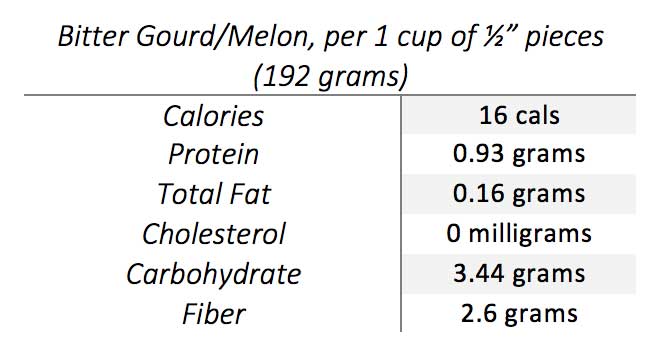What Is Bitter Melon?
Also known as bitter gourd, bitter squash, balsam pear, or ampalaya, bitter melon is a small plant, considered to both a fruit and vegetable. Its use varies across regions – mostly used as a vegetable in India and other Asian countries or modernized into medications and alternative therapies. The appearance looks much like a green cucumber, but with a rough and “warty” exterior skin. When cut into, the edible flesh surrounds multiple seeds, resembling larger pumpkin seeds.
Bitter Melon Nutrition
Commonly with any plant, calories are low for a high food volume. As indicated below, one cup of raw bitter melon pieces is a miniscule 16 calories! It also supplies adequate fiber, close to three grams per cup. Renowned vitamins and minerals bitter melon contains include vitamin C (over 100% of the RDA!), vitamin K, vitamin A, folate, zinc, and potassium.

*Adapted from USDA’s National Nutrient Database
Benefits of Bitter Melon
Diabetic Management
General recommendations suggest 50 to 100 milliliters of bitter melon juice or consuming 900 milligrams of the fruit three times each day may help regulate blood sugar levels. However, the clinical research is lacking and bitter melon use should not replace other diabetic management practices.
Weight Loss
Like most plants, bitter melon is low in calories but high in fiber. Consuming the plant can promote weight loss or keep weight within a healthy body mass index (BMI) range – a normal BMI is indicated as 18.5 to 24.9.
Cardiovascular Health
The fiber found in bitter melon can reduce the risk of heart disease by lowering cholesterol. Additionally, the vitamin K content is imperative in the role of blood clotting.
Prevent Constipation
Also related to its fiber content, bitter melon can ease digestion and prevent constipation. When increasing fiber intake, it is important to also increase fluid intake. High fiber with low fluid can actually cause constipation.
Anti-Aging
Bitter melon also contains vitamin C, a powerful antioxidant that fights against damaging ultraviolet (UV) light exposure and major risk factor in skin cancer development. Keeping cells undamaged can further slow down the aging process. Vitamin C also plays a role in collagen production. Collagen is a protein that helps maintain the structure of bone, tendon, skin, cartilage and all other connective tissue. Several studies conclude a high intake of vitamin C contributes to better skin appearance and decreases in skin wrinkling.
5 Ways to Use Bitter Melon
Using bitter melon may be an obstacle or challenge to cook with related to its strong, bitter taste. Commonly, the unique vegetable is lightly fried, boiled, steamed, or roasted.
1. Eat as A Side
Though the outer skin is edible, most individuals remove an outer thin layer to reduce the rough outer texture. The gourd is then cut length-wise to allow the location and removal of the seeds and fibers. Cut into small pieces and place into a lightly greased (with olive oil or nonstick spray) skillet over a medium heated stove. Saute and stir until the bitter melon is lightly toasted and serve with a lean protein such as chicken or beef.
2. Compliment A Salad
Though salads are often prepared in their raw form, it is important to add bitter melon onto it after some sort of cooking technique. If lightly frying, place onto a paper towel prior to serving to absorb excess oil and reduce soggy greens. Add to an Asian-inspired salad with fresh spinach, chicken, mandarin oranges, sesame seeds, and slivered almonds.
3. Throw into Soups
Though bitter melon can offer bulk to a wide-variety of soups, its presence mostly exists in oriental recipes. Swap a traditional bowl of chicken and noodles with a stuffed bitter melon soup or Vietnamese-style pork and bitter melon soup.
4. Add into Curries and Rice
More standard to its origin, the vegetable is often consumed in curries and rice. The spices help to cut the bitterness of the small gourd while allowing versatility and a variety of bold flavors.
5. Drink as a Tea
In addition to its utilization in meals and dishes, the plant can also produce a bitter melon tea. Also known as ampalaya tea, it is created from the actual fruit, leaves and stems of the plant or from its extract.






